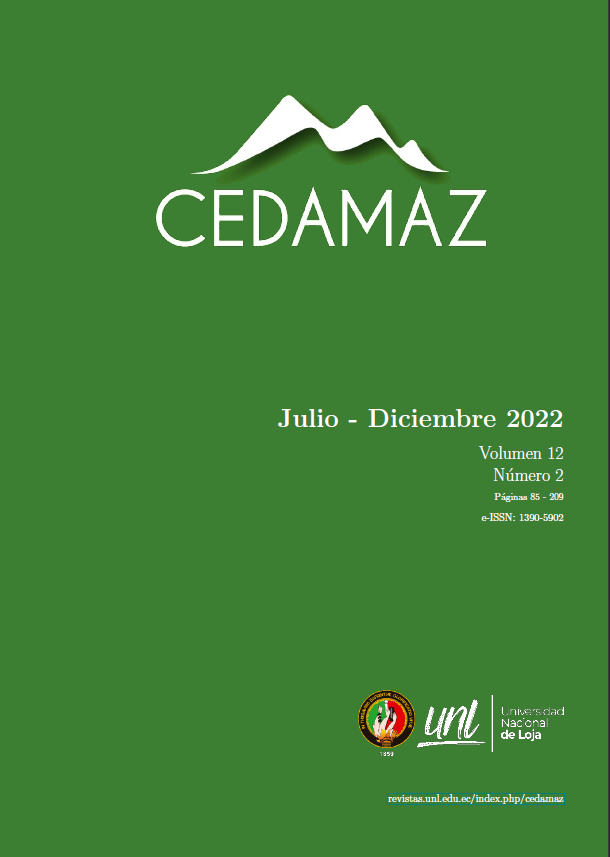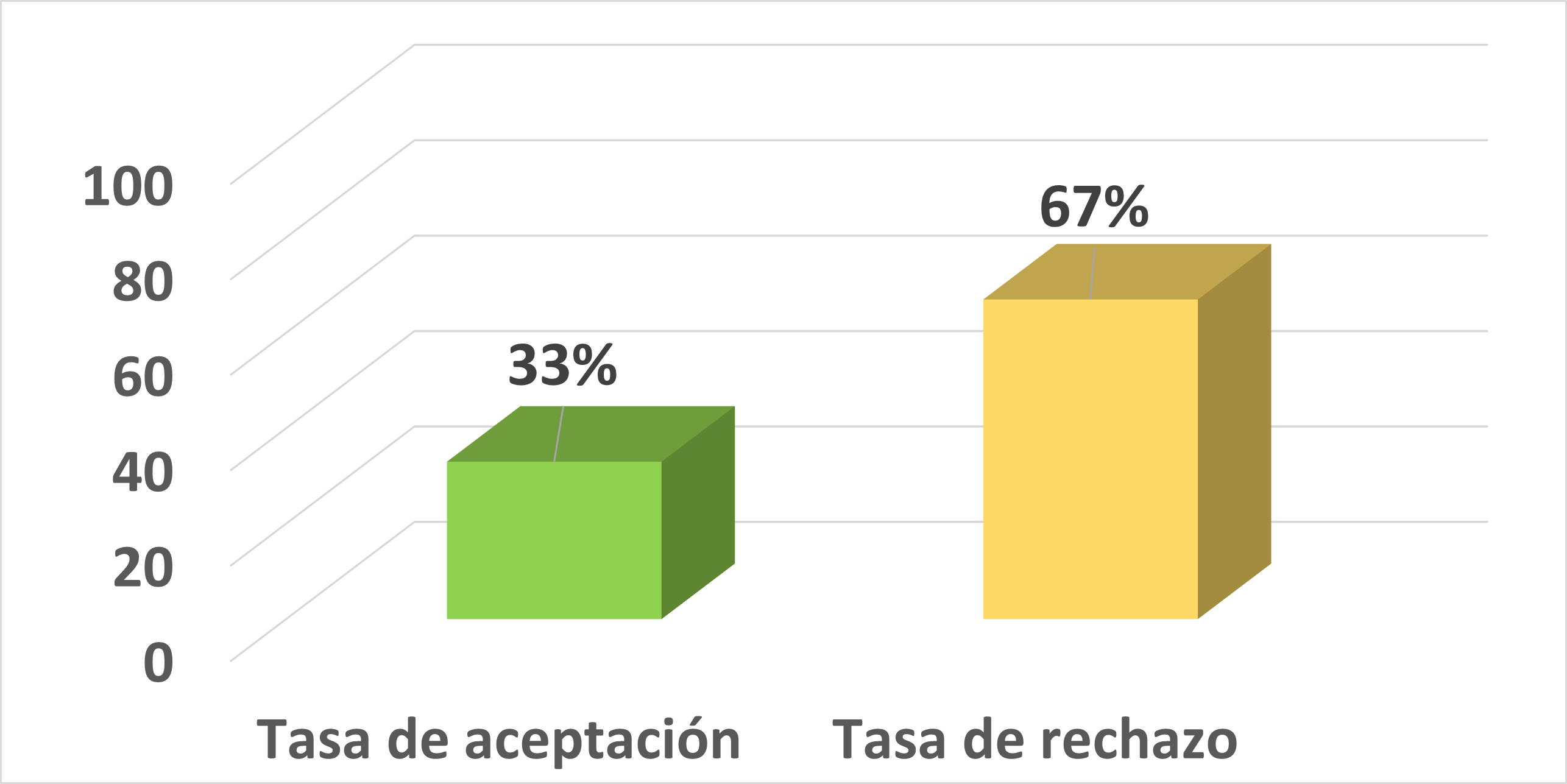Determination of the growth curve in the Creole goat “Chusca Lojana” from the dry forest of the southern region of Ecuador
DOI:
https://doi.org/10.54753/cedamaz.v12i2.1216Abstract
The present work aimed to study the growth curve of the Creole goat Çhusca Lojana"from the dry forest of the province of Loja, Ecuador. The adjustment of four growth models (Logistic, Von Bertalanffy, Brody and Gompertz) was evaluated and the percentage of maturity reached at different ages was estimated. Weight records of animals (56 males and 188 females of various ages) were used, using the SAS NLIN procedure. The Brody model was the best adapted to describe the growth curve of the Chusca Lojana goat in the extensive production system of the dry forest, and serves as an indicator of genetic and environmental evaluation. It determined the optimal age at slaughter and helped to establish management strategies, feeding and selection of the best genotypes. In the description of the growth curve for females and males, weights at maturity of 40 ± 1.3 kg and 62.5 ± 4 kg, respectively, were estimated. The maturity reached at four and six months of age was 32 % and 40 % for females, while it was 23 % and 31 % in males, identifying a minimum growth after 42 and 38 months of age for females and males, respectively.References
Aguirre, L., Maza, T., Quezada, M., Albito, O., Flores, A., Camacho, O., Martinez, A., BioGoat Consortium y Delgado, J.V. (2020). Genetic Characterization of the “Chusca Lojana”, a Creole Goat Reared in Ecuador, and Its Relationship with Other Goat Breeds. Animals, 10(6), 1026. DOI: https://doi.org/10.3390/ani10061026
Aguirre, L., Maza, T., Quezada, M., Albito, O., Armijos, D.R., Flores, A. y Camacho, O. (2021). Descripción morfométrica y faneroptica de la cabra “Chusca lojana” del bosque seco del Sur del Ecuador. Archivos de Zootecnia, 70(270), 172-176. DOI: https://doi.org/10.21071/az.v70i270.5469
Alexandre, G., Aumont, G., Fleury, J., Coppry, O., Mulciba, P. y Nepos A. (1997). Producción semi-intensiva de pastos de cabras de carne en el trópico húmedo: el caso de las cabras criollas sobre pangola (Digitaria decum bens) en Guadalupe. INRA Prod. Anim., 10(1), 43-53. DOI: https://doi.org/10.20870/productions-animales.1997.10.1.3976
Alexandre, G., Aumont, G., Despois, P., Mainaud, J.C., Cppry, O. y Xandé, A. (1999). Productive performance of Guadeloupean Creole goast during the suckling period. Small Ruminant Research, 34(2), 155-160. DOI: https://doi.org/10.1016/S0921-4488(99)00051-6
Bahreini, B.M., Aslaminejad, A.A., Sharifi, A.R. y Simianer, H. (2014). Comparison of mathematical models for describing the growth of Baluchi sheep. Journal Agriculture Science Technology, 14(1), 57-68.
Bathaei, S.S. y Leroy, P.L. (1996). Growth and mature weight of Mehraban Iranian fat-tailed sheep. Small Ruminant Research, 22(2), 155-162. DOI: https://doi.org/10.1016/S0921-4488(96)00888-7
Bembridge, T.J. y Tapson, D.R. (1993). Communal Livestock Systems. In: Livestock Production Systems. Maree and Casey (Eds.) Pretoria Agri Development Foundation, 361-373.
Brody, S. (1945). Bioenergetics and growth, with special reference to the efficiency complex in domestic animals. New York. Rheinhold, 645.
Carneiro, P.L.S., Malhado, C.H.M., Affonso, P.R.A., Pereira, D.G., Suzart, J.C.C., Ribeiro, M.J.R. y Rocha, J.L. (2009). Curva de crescimento em caprinos, da raça Mambrina, criados na caatinga. Revista Brasileira de Saúde e Produção Animal, 10(3), 536–545.
Chemineau, P., Baril, G., Leboeuf, B., Maurel, MC. y Cognie, Y. (1996). Recent advances in the control of goat reproduction. 6th Int. Conf. on Goats Beijing, International Academic Publishers, Beijing, China: 776-784.
Davidian, M. y Giltinan, D.M. (1996). Nonlinear models for repeated measurement data. 2.ed. Chapman Hall Edit. London, England.
Draper, N.R. y Smith, H. (1980). Applied regression analysis. 2.ed. John Wiley & Sons Edit. New York, United State. FAO. (1994). El estado mundial de la agricultura y la alimentación 1994. Dilemas del desarrollo y las politicas forestales. FAO, Roma-Italy.
Figueiredo Filho, L.A.S., Sarmento, J.L.R., Campelo, J.E.G., Da Silva Santos, N.P., De Sousa, J.E.R. y Biagiotti, D. (2012). Fatores ambientais e genéticos sobre a curva decrescimento de caprinos mestiços. Comunicata Scientiae, 3(3), 154-161.
Freitas, A.R.D. (2005). Curvas de crescimento na produção animal. Revista Brasileira de Zootecnia, 34(3), 786795. DOI: https://doi.org/10.1590/S1516-35982005000300010
Gbangboche, A.B., Glele-Kakai, R., Salifou, S., Albuquerque, L.G.D. y Leroy, P.L. (2008). Comparison of nonlinear growth models to describe the growth curve in West African Dwarf sheep. Animal, 2(7), 1003-1012. DOI: https://doi.org/10.1017/S1751731108002206
Gbangboche, A.B., Alkoiret, T.I., Salifou, S., Farnir, F., Leroy, P.L., Abiola, F.A. (2011). Growth pattern of purebred West African Dwarf sheep and its crosses with the West African long legged. Research Journal of Animal Sciences, 5, 6–13.
Ghavi N. (2015). Modeling the growth curve of Iranian Shall sheep using non-linear growth models. Small Ruminant Research, 130, 60-66. DOI: https://doi.org/10.1016/j.smallrumres.2015.07.014
Lupi, T.M., Nogales, S., León, J.M., Barba, C. y Delgado, J.V. (2015). Characterization of commercial and biological growth curves in the Segureña sheep breed. Animal, 9(8), 1341-1348. DOI: https://doi.org/10.1017/S1751731115000567
Mansour, H., Jensen, E.L. y Johnson, L.P. (1991). Analysis of covariance structure of repeated measurements in Holstein conformation traits. Journal of Dairy Science, 74(8), 2757-2766. DOI: https://doi.org/10.3168/jds.S0022-0302(91)78455-5
Martínez-Rojer, R.D., Torres-Hernández, G. y MartínezHernández, S. (2014). Caracterización fenotípica, productiva y reproductiva de la cabra blanca Criolla del"Filo Mayor"de la Sierra Madre del Sur en el estado de Guerrero. Nova scientia, 6(11), 25-44. DOI: https://doi.org/10.21640/ns.v6i11.64
Maynard, L.A. y Loosli, J.K. (1969). Animal Nutrition, 6th Ed. McGraw-Hill Book Co. Inc. New York.
McManus, C., Evangelista, C., Fernandes, L.A.C., Miranda, R.M., Moreno-Bernal, F. E. y Santos, N.R. (2003). Curvas de Crescimento de Ovinos Bergamácia Criados no Distrito Federal. Revista Brasileira de Zootecnia, 32(5), 1207–1212. DOI: https://doi.org/10.1590/S1516-35982003000500022
Najari, S., Ben-Hamouda, M., Khaldi, G., Hatmi, H. y Khorchani, T. (2000). Improvement of goat production in arid regions by the use of exotic breeds. In: 7th Conference International on Goats. Tours, France: 211-214.
Najari, S., Ben-Hamouda, M. y Knaldi, G. (2002). Kid´s genotype expression under arid conditions. In Proceedings of the 7th World Congress on Genetic Applied to livestock Production. Montpellier, France: 401– 404.
Nelder, J.A. 1961. The fitting of a generalization of the logistic curve. Biometrics, 17(1), 89-110. DOI: https://doi.org/10.2307/2527498
Ratkowsky, D.A. (1990). Handbook of nonlinear regression models. New York: 241. Rodero, A., Delgado, J.V. y Rodero, E. (1992). Primitive Andalusian livestock and their implications in the discovery of America. Archivos de Zootecnia, 41(154), 383–400.
Rossanigo, C.E., Friguerio, K. y Silva-Colomer, J. (1995). Producción de la cabra criolla sanluiseña (Argentina). Veterinaria Argentina, 16(151), 24-33.
Sandland, R.L. y McGilchrist, C.A. (1979). Stochastic growth curve analysis. Biometrics, 35(1), 255–271. DOI: https://doi.org/10.2307/2529948
Sarmento, J.L.R., Regazzi, A.J., Sousa, W.H.D., Torres, R.D.A., Breda, F.C. y Menezes, G.R.D. (2006). Estudo da curva de crescimento de ovinos Santa Inês. Revista Brasileira de Zootecnia, 35(2), 435-442. DOI: https://doi.org/10.1590/S1516-35982006000200014
Sharma, K., Saini, A.L., Singh. N. y Ogra, J.L. (1998). Seasonal variation in grazing behaviour and forage nutrient utilization by goats on a semi-arid reconstituted silvipasture. Small Ruminant Research, 27(1), 47-54. DOI: https://doi.org/10.1016/S0921-4488(97)00024-2
Tsukahara, Y., Chomei, Y., Oishi, K., Kahi, A.K., Panandam, J.M., Mukherjee, T.K. y Hirooka, H. (2008). Analysis of growth patterns in purebred Kambing Katjang goat and its crosses with the German Fawn. Small Ruminant Research, 80(1-3), 8-15. DOI: https://doi.org/10.1016/j.smallrumres.2008.07.030
Ulutas, Z., Sezer, M., Aksoy, Y., Sirin, E., Sen, U., Kuran, M. y Akbas, Y. (2010). The effect of birth types on growth curve parameters of Karayaka lamb. Journal of Animal and Veterinary Advances, 9(9), 1384–1388. Van Niekerk, W.A. y Casey, N.H. (1988). The Boer Goat II. Growth, nutrient requirements, carcass and meat quality. DOI: https://doi.org/10.3923/javaa.2010.1384.1388
Small Ruminant. Research, 1(4), 355-368. Von Bertalanffy, L. (1957). Quantitative laws in metabolism and growth. The quarterly review of biology, 32(3), 217-231. DOI: https://doi.org/10.1086/401873
Winsor, C.P. (1932). The Gompertz curve as a growth curve. Proceedings of the National Academy of Sciences of the United States of America, 18(1), 1-8. DOI: https://doi.org/10.1073/pnas.18.1.1
Published
How to Cite
Issue
Section
License
Copyright (c) 2022 CEDAMAZ

This work is licensed under a Creative Commons Attribution-NonCommercial-NoDerivatives 4.0 International License.
Those authors who have publications with this journal, accept the following terms:
- After the scientific article is accepted for publication, the author agrees to transfer the rights of the first publication to the CEDAMAZ Journal, but the authors retain the copyright. The total or partial reproduction of the published texts is allowed as long as it is not for profit. When the total or partial reproduction of scientific articles accepted and published in the CEDAMAZ Journal is carried out, the complete source and the electronic address of the publication must be cited.
- Scientific articles accepted and published in the CEDAMAZ journal may be deposited by the authors in their entirety in any repository without commercial purposes.
- Authors should not distribute accepted scientific articles that have not yet been officially published by CEDAMAZ. Failure to comply with this rule will result in the rejection of the scientific article.
- The publication of your work will be simultaneously subject to the Attribution-NonCommercial-NoDerivatives 4.0 International (CC BY-NC-ND 4.0)









